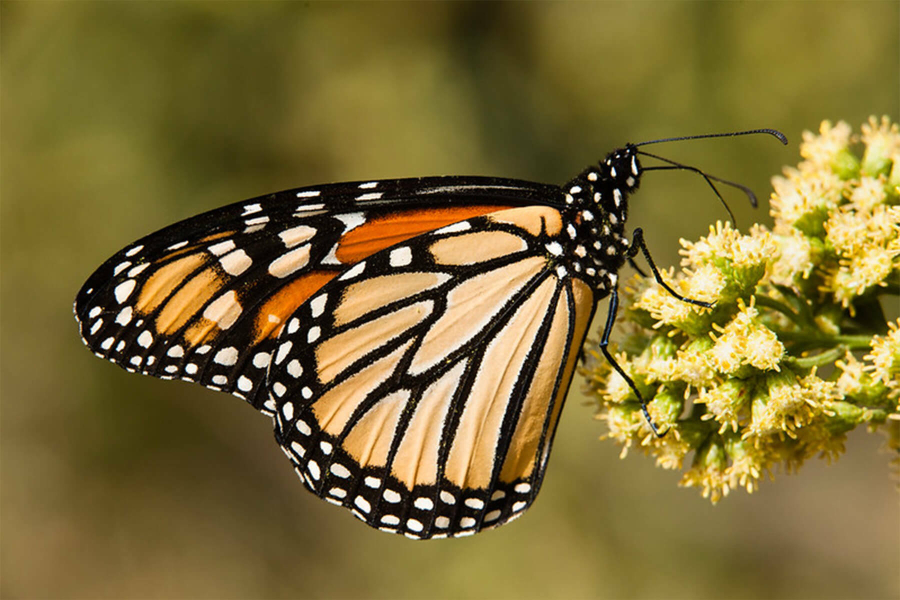Plant a Butterfly Garden
Planting a butterfly garden is a great way to attract and support wildlife while adding green spaces to a yard.

As our neighborhoods become more developed, vital wildlife like butterflies have a more difficult time finding the native plants that provide quality habitat. The decline of pollinators has a direct impact on the entire food web—limiting food sources for bugs and birds—while keeping our plants and crops from getting pollinated.
One of the best ways to support butterflies is to build a butterfly garden: an area in your yard that provides food, shelter and water for butterflies in all stages of their life cycle.
When building a butterfly garden, you can let your creativity shine and become more in touch with how these amazing critters live their lives. Butterfly gardens not only bring more beautiful and beneficial wildlife to your yard, but the plants you add will help secure the soil and absorb stormwater runoff, thereby improving the health of local waterways.
Project Time Estimation
It can take several hours to research and then purchase the plants and materials you need, another hour to plan the garden, and then a few more hours to plant, mulch and water the plants.
Supplies
- Soil
- Host plants (to support caterpillars)
- Flowering plants (to support adult butterflies)
- Mulch
- Flat stones or large rocks (optional)
- Fencing (optional)
Materials
- Gloves
- Hand shovel
- Wheelbarrow
Process overview
- Choose a location
- Select your host plants
- Select your flowering plants
- Select a few herbs
- Plan out the garden
- Plant and mulch
- Create a puddling and sunning spot
- Add fencing
1. Choose a location
The first thing you need to do is find a good location for your butterfly garden. The garden can be as big as you want, but will need to be in a spot that gets a lot of sunlight. Consider putting the garden near plants and bushes where you’ve already seen caterpillars and butterflies. Lay down your garden bed with soil—it can be raised or on the ground.
2. Select your host plants
While butterflies feed on nectar from flowers, their caterpillars eat the leafy tissues of plants themselves. Most caterpillars are specialists, meaning they will only eat one species (or several related species). The type of plant a caterpillar needs to survive is known as its “host plant.”
Your second task after choosing a location is to acquire host plants for the garden. Popular host plants include milkweed, violet, and clover. Here are a few resources that you can use to choose host plants that are native to the Chesapeake region.
- Montgomery County Butterfly Gardening Information
- The Butterfly Society of Virginia
- Gardening for Butterflies - Penn State Extension
The most important thing to consider is choosing plants that are native to your region. Not only will natives best support local wildlife, but they also require less water than non-natives, limiting your water usage. As far as how many host plants to pick, a ratio of 1 host plant for every 3 flowering plants is a good mix for your butterfly garden.
3. Select your flowering plants
The bulk of your butterfly garden will be flowers that butterflies use for nectar. When choosing flowering plants, variety matters. Pick a wide range of colors, sizes and shapes to give your butterflies options. You also want to try and have plants blooming throughout the year. Pick plants that will bloom in each of the four seasons. You should also include a few annual plants, which are plants that sprout, bloom and die within one year.
The same resources above have information for matching flowering plants to butterflies.
4. Plan out your garden
Before you start digging be sure to plan out the garden. Bring the plants over to the bed you are going to put them in and lay them out where it makes sense. Don’t be afraid to put the plants close together—the more crowded it is, the less likely weeds will grow. Save a small space (about three feet) for a puddling and sunning spot (more on that to come!).
5. Plant and mulch
Now you’re ready to get the plants in the ground. Like you would with any other plant, dig a large enough hole so that the plant is about an inch above the ground, gently separate the roots, place the plant in the hole and pack in the remaining soil. Once your plants are all in, mulch the entire garden. This will add nutrients to the plants and protect them from the weather.
6. Create a puddling and sunning spot
Butterflies get their nutrients from nectar but they get minerals from water. They do so through a process known as “puddling,” which is when they sit in damp areas and suck up water. You can create a puddling area using small rocks and stones set in a small dish. Whenever it rains, these areas will collect water and provide butterflies a place to puddle. Butterflies also enjoy places to sun, so you could also add a large, flat stone or some other surface for them to sit on.
7. Add fencing for chrysalises to form
Caterpillars need sturdy objects to form their chrysalises on before they transform into butterflies. The insect should be able to find a spot on a tree or plant, but if you’d like to provide a space yourself, you can add a row of fence-like material to the garden. If you live in a highly urban area, this is especially useful.
With all this in place, you should have a superb butterfly garden that attracts pollinators and helps your yard retain its stormwater runoff. All you have to do is maintain the garden and enjoy your visitors!
